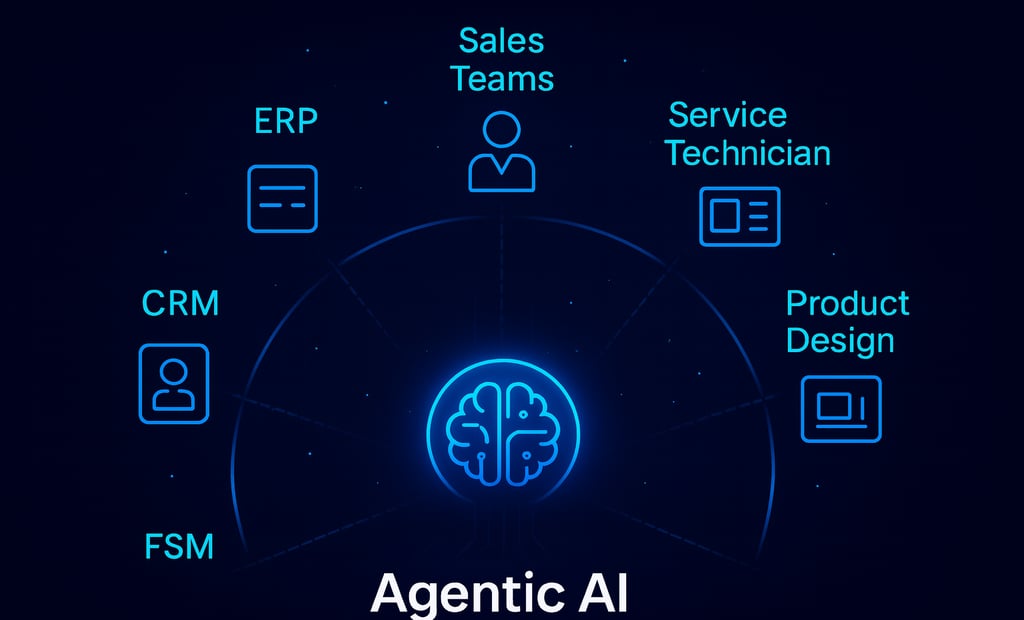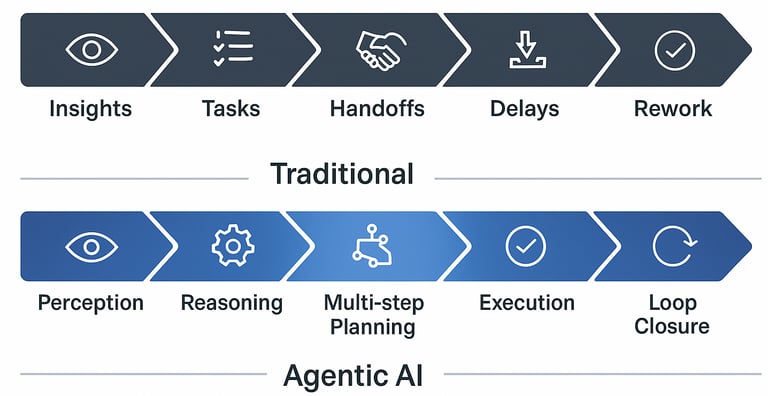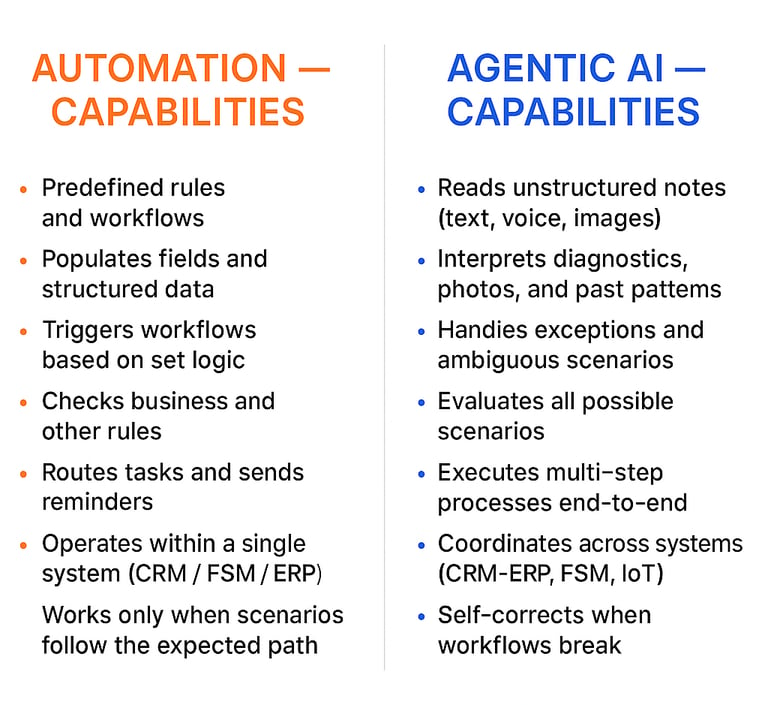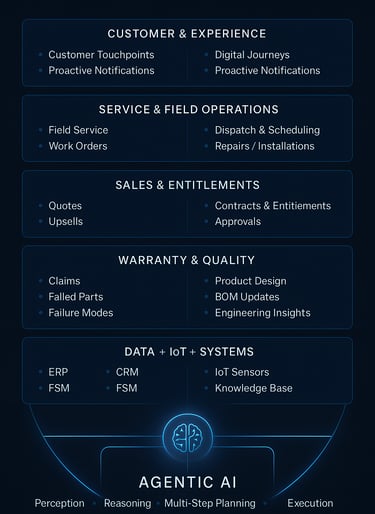Agentic AI in After-Sales: The Missing Execution Layer That Automation Couldn’t Fix
Mihir Joshi


Manufacturers have invested heavily in CRM, ERP, FSM, warranty, IoT and predictive analytics platforms. Yet the frontline reality hasn’t changed enough:
Repeat visits remain high
Warranty costs keep rising
Cross-team handoffs still break
Customers receive disconnected, tone-deaf communications
Revenue opportunities identified in service never convert
Product teams remain blind to real failure patterns
The issue isn’t data. It’s not lack of tools.
It’s execution - the messy, cross-system, multi-team work that determines whether good service strategies actually deliver results.
Automation, integrations and predictive models improved isolated steps. But they couldn’t improve how those steps connect, adapt, or complete in the real world. While the initial GenAI buzz has started to level off, especially in areas where outputs remain disconnected from real workflows, the emergence of Agentic AI offers something fundamentally different - real-world execution, not just content generation.
Traditional tools improved tasks, but hit a ceiling
Automation and workflows excel when process pathways are predictable. They can populate fields, trigger cases, calculate entitlements, and move tickets forward. They follow rules, and they do it efficiently.
But service operations aren’t rule-perfect. They’re exception-heavy, context-dependent, and dependent on coordination between teams that don’t always prioritize the same outcomes.
Traditional tools break down when:
the process doesn’t follow the expected path
data is incomplete or inconsistent
multiple systems must be coordinated
decisions require interpretation, not triggers
unstructured data drives outcomes
multi-step sequences depend on follow-through
These are the gaps where service quality, CX, and revenue are lost, and that's where agentic AI steps in.
Warranty looks straightforward on paper. In reality, it generates some of the most complex execution failures in after-sales. Here's a short comparison of how Warranty Management is handled by current systems (automation) and how it can be handled by AgenticAI.
How automation handles warranty today
Automation populates warranty fields, triggers claim workflows, checks contract rules, and routes tasks to queues. This works only as long as the case fits the predefined logic.
Where real warranty processes actually break
Multiple overlapping warranties
Missing or ambiguous technician notes
Incorrect failure code selection
Incomplete asset history
Partial coverage or disputed eligibility
Unclear goodwill scenarios
Parts availability issues
Customer frustration escalating during delays
Once an exception appears, the workflow collapses into manual, multi-team digression, creating leakage, rework and slow resolution.
Case Example: Warranty Entitlement - Where Automation Ends and Agentic Begins
Most organizations fail to drive sevice revenue, not due to technology gaps but because of execution gaps - the very area Agentic AI is designed to fix.
Agentic AI systems don’t operate on “if X then Y.”
They operate on goals, adapting steps along the way.
They can reason, decide, and act across multiple systems, and they can self-correct when reality shifts. They connect teams, close loops, enforce follow-through, and interpret unstructured signals (notes, images, logs, voice) to drive the right next action.
Agentic AI finally provides what after-sales operations have always lacked: an execution layer that ensures the right actions happen, in the right order, at the right moment, even when processes diverge from the script.
Why Agentic AI Solves the Execution Gaps Automation Cannot


While automation often breaks at critical handoffs, Agentic AI maintains continuity by planning, adapting, and closing loops across teams and systems.
How agentic AI handles the same case
Agentic AI evaluates the scenario holistically:
Reads free-text technician notes
Interprets images or diagnostic reports
Gathers failure patterns from similar assets
Checks contract, warranty and extended warranty
Determines coverage overlap or exclusions
Identifies goodwill recommendations
Initiates claims, escalations or technical reviews
Updates CRM/FSM
Informs the customer about next steps
Tracks the entire chain to closure
The difference is not improved automation, it’s improved execution. Agentic AI keeps the warranty process on track end-to-end, without requiring human coordination at every exception.


Agentic AI introduces reasoning and cross-system coordination that traditional automation cannot achieve, enabling stronger and more reliable execution in after-sales processes.
Where Agentic AI Will Transform After-Sales and Field Service Operations
Below are three high-impact areas where agentic AI does what traditional tools simply cannot.
1. Customer Journey Orchestration (Touchpoints That Adapt in Real Time)
In most manufacturing and service organizations, customer communications run on independent tracks:
marketing sends campaigns on fixed cycles; CRM triggers feedback after case creation; sales sequences begin automatically; and service communications often operate in isolation. This creates a disconnected experience, especially when a customer is waiting for a repair, a part, or a technician.
The execution problem
The systems involved do not talk to each other in a way that reflects reality. A customer with an unresolved issue may receive:
a sales pitch for a new product
a cross-sell email
an NPS survey
a renewal reminder
All of these are technically “correct” from a system perspective — and completely wrong from a customer perspective.
How agentic AI fixes it
Agentic AI works across CRM, marketing automation, service platforms, and order systems to decide the right next touchpoint based on live context. It can:
detect open service or warranty cases
suppress feedback and NPS triggers until resolution
pause sales cadence steps automatically
block or postpone marketing campaigns that would feel insensitive
send real-time service updates instead
recommend compensation or goodwill when delays are likely
personalize communication based on customer sentiment or past frustration
resume normal journeys once the issue is resolved and confirmed
This is execution intelligence. Instead of “push everything that the system thinks is due,” agentic AI ensures the customer journey reflects the customer’s reality, not the system’s schedule. As I discussed previously in AI won’t replace customer service, frontline roles don’t disappear, they become augmented. Agentic AI simply ensures the right actions happen around them
2. Service - Sales Revenue Handoff (Recovering the Revenue Leakage You Don’t See)
Technicians are the earliest detectors of new revenue potential such as failing parts, ageing assets, safety-risk components, consumables near end-of-life. Yet most of these insights die in the system: they’re logged, but not actioned. This is one of the biggest contributors to the untapped service revenue opportunity many manufacturers fail to capture today
The execution problem
The handoff between service and sales is one of the biggest revenue leaks in after-sales.
What typically happens is:
technician logs a replacement recommendation
CRM captures the note
the customer shows intent (“go ahead, send me the quote”)
the sales rep doesn’t act quickly enough
customer loses momentum or trust
the opportunity dies
This is not a technology gap — it’s an execution gap. Nobody owns the follow-through.
How agentic AI fixes it
Agentic AI can act as a digital coordinator that closes these loops without human overhead. It can:
read technician notes and classify genuine sales opportunities
confirm pricing, contract terms, warranty conditions, and availability
draft the quote automatically
send the quote to the customer or route it to the sales rep
chase the sales rep if no action is taken
escalate appropriately
update the service order and CRM with outcomes
notify the technician that their recommendation was acted upon
confirm the next steps to the customer
With agentic AI, the system no longer depends on sales reps noticing a task or technicians manually reminding customers. The handoff becomes automatic, consistent, and accountable, unlocking revenue that was previously slipping through cracks.
3. Engineering Feedback Loop (Closing a Loop That Has Never Actually Worked)
This is one of the most strategic use cases, and the least addressed historically. Organizations claim they have “closed loops” between service, warranty, quality, and engineering.
In reality, these loops are manual, slow, and dependent on presentations, meetings, and selective interpretation of field data.
The execution problem
Manufacturers struggle to convert real-world usage and failures into actionable design changes because:
field data is unstructured
warranty data is coded inconsistently
failure modes are described differently by each technician
engineering teams rarely see the raw voice of the field
insights arrive too late in product life-cycles
This leads to repeated defects, high warranty cost, and slow product improvement.
How agentic AI fixes it
Agentic AI creates continuous, automated, pattern-driven feedback that finally closes the loop between field service and engineering. It can:
read technician notes, photos, videos, and call transcripts
detect patterns in repeated failures
cluster symptom types and correlate with operating conditions
match patterns with known design weaknesses
propose design modifications or reliability enhancements
draft engineering reports containing root-cause analysis
generate BOM adjustments or component recommendations
send a structured “field insights” dossier to product or R&D teams
track whether recommended changes were acted upon
This becomes a real feedback loop, not a quarterly meeting. It compresses the time from field symptom → design action, which directly lowers warranty cost and strengthens the next generation of products.
Tools & Platforms: Everyone Is Going “Agentic,” but Not Fully
Platforms like Salesforce, ServiceNow, SAP, Oracle, Conga, PTC etc. have started branding features as “agents” or “copilots.” These tools are evolving fast, but they remain largely platform-bound, not enterprise-wide execution layers.
CRM providers, FSM platforms, ERP suites, CPQ tools, and even parts logistics systems are repositioning their AI add-ons as agentic capabilities.
But the reality is this: Most of these agents still operate within their native ecosystem. These tools are valuable, but they remain platform-local and tightly bound to the rules, data models, and workflows of a single system.
Gartner warns of “agent-washing” and projects that “over 40 % of agentic AI projects will be scrapped by 2027” without clear business value.
True Agentic AI goes beyond this. It reasons across CRM + FSM + ERP + CPQ + IoT + Warranty + Product systems, coordinating actions that no single tool can see end-to-end.
The future is a enterprise-wide agentic orchestration, where an AI can interpret signals from any system, resolve conflicts between teams, coordinate multi-step sequences, and close loops across the entire service lifecycle.
This distinction matters: platform-bound agents automate tasks; enterprise agentic systems execute outcomes.
ROI: Why Service Leaders Must Pay Attention
When execution gaps close, the financial results compound across cost, revenue and customer experience. Industry research consistently shows:
10–25% reduction in warranty leakage
20–40% faster MTTR
8–15% FTFR improvement
15–30% reduction in cost per service order
5–12% uplift in service-driven revenue
And these gains stack with softer benefits: stronger customer trust, fewer escalations, more reliable teams, and faster product improvement cycles.
Agentic AI isn’t another tool - it’s the operating layer that finally makes digital service strategies executable. The best approach to drive faster ROI is to start small with one high-impact execution loop (e.g., service→sales handoff), prove value, then expand.
Agentic AI isn’t plug-and-play. Getting value requires foundations:
integrated data from CRM, FSM, ERP, IoT
predictable process paths (at least at a baseline level)
accessible knowledge assets
cross-functional ownership (service, sales, product, warranty)
governance, accountability and human oversight
Manufacturers don’t have a “data problem.” They have an execution problem. Automation made tasks faster. Agentic AI makes outcomes better by reasoning across ambiguity, coordinating across systems, and closing loops that have stayed open for years.
The next decade of competitive advantage in after-sales will come from operational intelligence, not from tools alone, but from systems that can actually run the work.
Agentic AI is the technology that finally brings this within reach. This aligns with the direction I described in Service Organization of 2030, where the most competitive teams operate as connected, insight-led service networks.”


Agentic AI integrates with every layer of the after-sales lifecycle, from customer experience to engineering, to deliver real-time, end-to-end operational intelligence
Which part of your service operation would you trust an agent to run first?
I’d love to hear your take.
Author Info
Written by Mihir Joshi
After 15 years working with leading manufacturers, I created SmartServiceOps to share practical insights for the field service industry.
